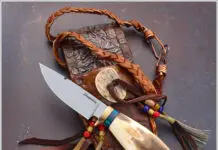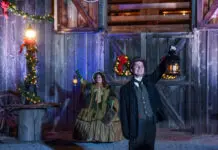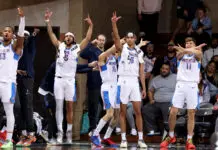Go ahead. You know you want to take a peek at Oklahoma City’s The Girlie Show. The original “art show with a curve” (now in its ninth year) features cool stuff made by women artists and performers exhibiting everything from fine art to bare midriffs. Creativity and craftsmanship will be everywhere as this year’s Girlies put on a show about ideas, confidence, fearlessness and fun. Take that, Cosmo. Browse the goods and enjoy shows from Tulsa’s Eye Candy Burlesque, Perpetual Motion/Modern Dance Oklahoma, Teaze Dance and many others. Also take in the great food and music. For two days (Nov. 2-3), the Oklahoma City Farmers Public Market, 311 S. Klein, goes to the girls, which is sure to bring out the guys undoubtedly interested in the arts. Tickets are $15-$20. VIP Early Girlie admission is $50. For times, go to www.thegirlieshow.net
Of Models & Muses
Philbrook Museum of Art goes the distance with its next big exhibit, Models & Muses: Max Weber and the Figure, Nov. 4-Feb. 3.
Considered one of the most important American artists of the 20th century, Weber rode the torrent of art as it underwent the frantic evolution of the early 1900s that witnessed the shock of cubism and the abstractions of modernism that followed.
Weber was a Polish immigrant who came to America with his family when he was 10. After studying under Arthur Wesley Dow at the Pratt Institute in Brooklyn, he went to Paris where he met the most famous names in art of the day, including Pablo Picasso and Henri Matisse. By 1909, he was back in New York painting in the cubist style – which did not meet quickly with widespread acclaim.
Over time, this conduit of modern art would alter his approach to the line, going from hard to soft, but his subject was almost always the human form. This Philbrook original exhibit gauges Weber’s work and vision as artist and teacher, how the figure, perhaps, offered a personal haven when his work was under attack either socially or critically.
Figures of women in the home and in nature take on spiritual reflections in scenes of serenity and distress, often viewed as the artist’s reaction to the approach of World War II.
Models & Muses – assembled from both public and private collections – is that rare exhibition of an artist’s life offering the audience a map of his vision, inspiration and his legacy. Through his eye, the human body repeatedly is negotiated, read and rendered meaningful, yet never to the point of exhaustion.
Philbrook Museum, 2727 S. Rockford Road, Tulsa, is open daily except Mondays. Admission is $7-$9. Go online to www.philbrook.org for schedules and information about free admission.
Mary Poppins
Nov. 6-11 (OKC), 13-18 (Tulsa)
Just as she descended from a cloud above London under a black umbrella, Mary Poppins is about to make a similar entrance at the Oklahoma City Civic Center Music Hall, 201 N. Walker Ave. Celebrity Attractions steers the Broadway musical adaptation of Disney’s 1964 film Mary Poppins to Oklahoma complete with English countryside, high-stepping chimney sweeps and two rambunctious children hopelessly at odds with their father – a true Edwardian man and banker named George Banks. Enter the nanny with a magic touch and housework is a breeze, teatime is a hoot and cleaning chimneys is a fantastic job. Critics have given high marks for this live stage vision based on P.L. Travers children’s books, and that makes those of us who know the movie by heart excited about it, too. Mary Poppins runs for eight shows in Oklahoma City beginning at 7:30 p.m. Tuesday, Nov. 6. Tickets are $20-$45 at www.myticketoffice.com. The musical moves to the Tulsa Performing Arts Center, Third Street and Cincinnati Avenue, the following week for eight more shows from Nov. 13-18. Those tickets are also on sale now at www.myticketoffice.com.
OKC Thunder v. Portland Trail Blazers
Friday, Nov. 2, at 7 p.m.
The preseason is over, and by the time this bit appears online, the Oklahoma City Thunder will have beat the Dallas Mavericks in preseason at Wichita, Kan., and defeated San Antonio on the opposition’s home court, the AT&T Center, for the first official game of the season. Well, one is true, and the other is very likely to become fact if you’re a fan already operating in “thunder up” mode. Hopes are high for the team to make a return to the NBA finals a second year. After losing the championship in June to the Miami Heat, we’re counting on that dynamic duo of Kevin Durant and Russell Westbrook to break the team into another successful run sans our favorite Beard, Mr. James Harden, who was traded to Houston, in case you hadn't heard. Watch as a new game begins at the Chesapeake Energy Arena, 100 W. Reno Ave., OKC. Tickets start at $120. Find them at www.ticketmaster.com.
Dia de los Muertos Arts Festival
Thursday, Nov. 1, 5-10:30 p.m.
Living Arts of Tulsa’s Day of the Dead festival takes a Hispanic celebration of the lives of the deceased and builds an arts component that has made the annual Dia de los Muertos Arts Festival a new Tulsa institution. Hosted by Living Arts of Tulsa, the festival shuts down the Brady Arts District streets so revelers can walk, visit, shop, snack and enjoy music and folk dance performances. Indoors, visitors will find the Altared Spaces exhibit in the Living Arts galleries, 307 E. Brady St. Traditionally, altars are erected in memory of passed loved ones with their favorite objects, foods and belongings. Families sit up all night at cemeteries to be with their gone families and friends to celebrate the life. This festival only lasts until 10:30 p.m., and there’s plenty to do inside and outdoors, where you’ll find authentic folk dance performances, daring fire dancers with plenty of assistants and fire extinguishers on stand-by and the Parade of Skeletons. Sugar skulls, hot chocolate, great food vendors, arts, crafts, children’s activities and many other activities await. Who said the dead can’t have their day and eat it, too. For more on the festival, go online to www.livingarts.org.
Oklahoma Legends Awards
Thursday, Nov. 1, at 7 p.m.
Oklahoma has created some great artists, and the Oklahoma Center for Poets and Writers wants everyone to know about them. The Oklahoma State University-Tulsa-based center will honor three of them Thursday during Oklahoma Legends. The inaugural event is Thursday night at OSU-Tulsa Auditorium, 700 N. Greenwood Ave., where famous country musician Roy Clark and renowned authors N. Scott Momaday and S.E. Hinton will be awarded for leading their fields. Also scheduled to appear Thursday are the Tulsa Playboys, Jim Halsey, Michael Wallis and John Wooley (who just happens to be an Oklahoma Magazine contributing editor). Tickets to Oklahoma Legends are $15 each and available at www.myticketoffice.com. Go to www.osu-tulsa.okstate.edu for even more about the honorees.
Alfred Hitchcock’s The 39 Steps
Friday-Saturday, Nov. 2-3
Alfred Hitchcock had a sense of humor, but could he have envisioned his spy story like this? The Tulsa Performing Arts Center Trust brings the Broadway smash – which won two Tony and Drama Desk awards plus the Olivier Award for best comedy – to the Tulsa Performing Arts Center, 110 E. Second St. Performances are at 7:30 p.m. Friday and Saturday (Nov. 2-3) with a matinee at 2 p.m. Saturday. With more than 150 different characters populating this melodrama espionage caper, the production features only four actors changing costumes as quickly as they do accents and personalities to fill out this story, which begins when an ordinary man meets a mysterious woman in black. Life should be so adventurous. Tickets are $30-$40, available at www.tulsapactrust.org.
Nathan Gunn at Armstrong Auditorium
Thursday, Nov. 1, at 7:30 p.m.
Nathan Gunn’s name is practically synonymous with the words “opera” and “baritone.” Other words you’re likely to encounter in the numerous articles and reviews of his work: “Heartthrob,” “bare-chested” and “sexy.” By the way, we didn't make up that word, "barihunk." How much can the classical opera world take in one man? Let People magazine keep its “Sexiest Man Alive” list (which Gunn made in 2008). Serious music lovers are more interested in the voice and his roles in such works as Show Boat, Billy Budd, The Barber of Seville and American Tragedy, right? Whether by sight or sound, Gunn has become a megastar with a career that includes performances in the great houses everywhere: the Metropolitan Opera, the Paris Opera, Seattle Opera and Royal Opera House. As an in-demand performer, Edmond’s Armstrong Auditorium is certain to be packed Thursday night. Gunn opens the venue’s 2012-13 season with a recital of songs demonstrating his musical prowess and appeal. We wouldn’t be surprised if the concert sells out tickets. Do we have to explain that, too? Tickets are $28-$68, available at www.armstrongauditorium.org. The auditorium is located at 14400-B S. Bryant Road, Edmond.
Bob Dylan
Friday, Nov. 2, 7:30 p.m.
In 1969, Bob Dylan answered a few questions for Rolling Stone magazine (his first interview with the revolutionary publication) about his approaching tour.
From the interview …
RS: “When do you think you’re gonna go on the road?”
BD: “November … possibly December.”
RS: “What kind of dates do you think you’ll play – concerts? Big stadiums or small concert halls?”
BD: “I’ll play medium-sized halls.”
Dylan could play any size venue he wants today. Lucky for us, he’s making the spacious BOK Center, 200 S. Denver Ave., his next tour stop as he promotes his most recent album, September’s release Tempest. Mark Knopfler joins Dylan again after the pair toured together in Europe last year, bringing them both wide notice and success. Doors open at 6:30 p.m. For tickets, $45-$89, go online to www.bokcenter.com.
Last chance: Gladiator of the Political Pencil: The Cartoons of Thomas Nast
Thru Sunday, Nov. 4
Nothing cuts to the essence of election campaigning like a political cartoon, and those by Thomas Nast are considered by many to be the best. With less than a week to go before we decide who will sit in the White House for the next four years, consider a visit to Philbrook Museum of Art, 2727 S. Rockford Ave., this weekend. The exhibit Gladiator of the Political Pencil: The Cartoons of Thomas Nast concludes Sunday, Nov. 4. In the last half of the 19th century, Nast battled government corruption and elevated figures like Abraham Lincoln through his images that were widely printed. It’s his symbols, however, that have proved to be most influential on American culture – from the donkey and elephant representing the dominant political parties to his drawings of Santa and Uncle Sam. After a walk through of the cartoons of Thomas Nast, you’re likely to react to the fact that campaigns and their supporters have been sparring for decades in our country. It’s enough to make you laugh, cry or both. Museum hours are 10 a.m.-5 p.m. every Wednesday and Friday-Sunday. The museum is open until 8 p.m. every Thursday. Admission is $7-$9. For more, go to philbrook.org.






















